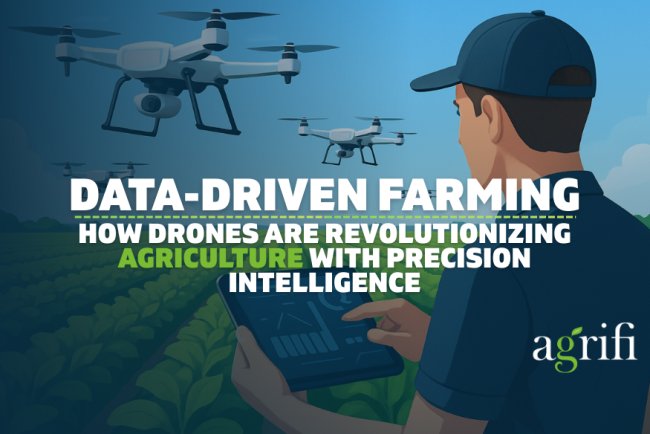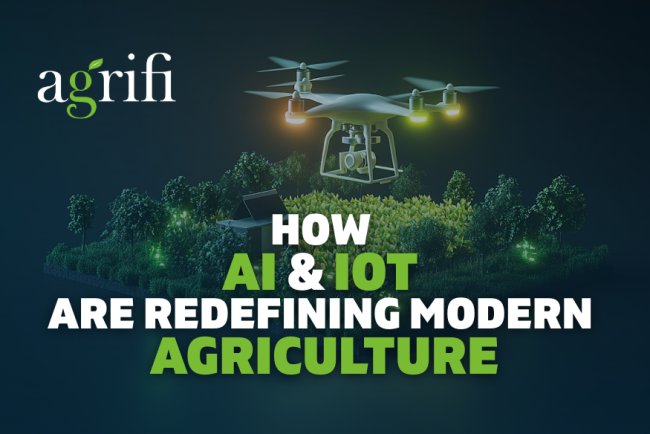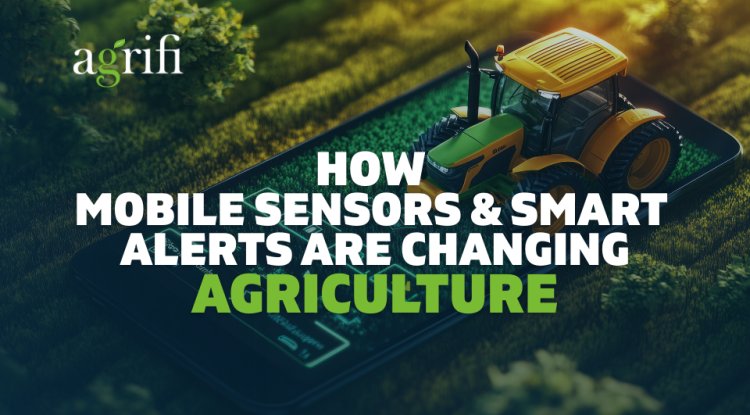10 Real-World Benefits of Predictive Analytics in Farming
Discover how predictive analytics empowers farmers to forecast yields, prevent pests, optimize inputs, and achieve climate-resilient, data-driven farming. Predictive analytics is reshaping agriculture through the power of data, AI, and IoT. From precision irrigation to early pest detection and yield forecasting, farmers now have real-time insights that turn uncertainty into strategy. This blog explores 10 real-world benefits showing how predictive analytics drives smarter, more sustainable, and profitable farming across global landscapes.

As global agriculture faces mounting pressures, climate variability, labor shortages, rising input costs, supply-chain disruption, and demand for more sustainable practices, the role of data-driven decision-making becomes central. Enter predictive analytics: the amalgam of historical data, real-time sensor information, machine-learning models, and domain knowledge that allows farmers and agri-businesses to forecast future events and act proactively.
In this blog, we unpack ten concrete benefits of predictive analytics in farming, backed by real-world case studies and global perspectives, from India to Japan, from smallholders to large-scale operations. Each benefit shows how this approach shifts farming from reactive to proactive, boosting productivity, resilience, and sustainability.
What is Predictive Analytics in Farming?
Predictive analytics uses algorithms and statistical models to analyze existing and historical data (weather, soil, crop health, pest incidence, market demand) to forecast outcomes (yield, disease risk, resource needs) and support decision-making.
In the agriculture context, this often sits at the intersection of IoT sensors, satellite & drone imagery, farm-machinery telemetry, and cloud/edge analytics, underpinning the “smart farming” or “precision agriculture” paradigm.
Why the Timing Matters
- The world population is projected to approach 10 billion by 2050, placing huge demand on agriculture to increase productivity while shrinking its environmental footprint.
- Rising input costs (fertilizer, water, energy) and climate-related risks (extreme weather, pests) make uncertainty reduction valuable.
- Digital infrastructure (sensors, connectivity, drone & satellite imagery) is now more accessible even in emerging markets, enabling data-driven farming at scale.
- Governments and global initiatives increasingly promote sustainable and regenerative agriculture: predictive analytics becomes a key enabler of resource efficiency and ESG (environment, social, governance) compliance.
The 10 Benefits
1. Yield & Production Forecasting
Predictive analytics enables farms to forecast crop yields with higher accuracy by analyzing historical yield data, current plant health imagery, weather, and soil condition trends.
Why it matters:
- Allows better planning for harvesting, storage, logistics, and market timing.
- Enables risk mitigation by identifying low-yield zones ahead of time.
- Provides a basis for contract farming or financing arrangements (where yield guarantees matter).
Global insight: In regions such as India and Japan, where rice, wheat, or specialty crops dominate, even small percentage improvements in yield forecasting translate into large savings and performance gains.
2. Optimized Resource Use (Water, Fertilizer, Pesticides)
By analyzing soil moisture sensors, weather forecasts, crop stage, nutrient levels, predictive models suggest optimal timing and quantity for irrigation, fertilizer, or pesticide application.
Why it matters:
- Reduces waste (e.g., over-watering, over-application of chemicals).
- Lowers input costs – a key pressure point especially for small and mid-sized farms.
Minimizes environmental impact (less groundwater depletion, less runoff, lower chemical loads).
Geographical nuance: In water-scarce zones (for example, parts of Chiba/ Kanto region in Japan or arid zones in India), precision irrigation guided by predictive analytics becomes a game-changer.
3. Early Warning for Pests & Diseases
Models can raise alerts when conditions align for pest outbreaks or disease proliferation (e.g., humidity + temperature + historical incidence).
Why it matters:
- Enables proactive intervention rather than reactive damage control.
- Lowers crop losses, improves quality, and reduces chemical usage (more targeted sprays).
- Supports farmer decision-making for when and where to scout or apply controls.
Implementation tip: Use satellite imagery + field sensors + historical outbreak maps to feed into your predictive models.
4. Optimal Crop & Field Selection
Predictive analytics helps match crop variety or planting schedule to field-specific conditions (soils, microclimate, water availability) by analyzing historical performance and current trends.
Why it matters:
- Maximizes return on land, especially in fragmented or heterogeneous farms.
- Supports rotational planning and risk diversification (e.g., picking more resilient varieties when forecast signals stress ahead).
Regional relevance: In Japan, for example, high‐value horticulture or rice paddies can benefit from fine-tuned variety selection and planting windows to match climatic patterns.
5. Supply Chain & Market Forecasting
Beyond the field, predictive analytics supports forecasting of commodity prices, demand cycles, logistics disruptions, and supply-chain bottlenecks.
Why it matters:
- Farmers or agribusinesses can decide when to sell, how much to produce or store, reducing margin risk.
- Helps co-ops, processors, and distributors align production with market demand and reduce waste.
Global scope: For export crops or international supply chains (e.g., Japanese specialty exports, Indian rice exports), forecasting demand and logistics risk is vital.
6. Equipment & Maintenance Efficiency
Using sensor data and predictive models, farms can anticipate equipment failures or maintenance needs (e.g., irrigation pumps, tractors) rather than reactively repairing breakdowns.
Why it matters:
- Reduces downtime, ensures operations proceed smoothly during critical windows (planting/harvest).
- Lowers maintenance costs and unexpected repairs.
Application tip: Combine telemetry from farm machinery with usage data, environmental data (dust, vibration), and model wear-out patterns.
7. Increased Resilience to Climate & External Shocks
Predictive analytics helps anticipate weather risks, flood/drought windows, extreme events or shifting pest pathways, enabling adaptation and resilience.
Why it matters:
- Farming is inherently risky; prediction reduces uncertainty.
- Especially crucial in regions susceptible to monsoon variation, typhoons, erratic rainfall, relevant in Asia Pacific including Japan.
Strategy: Use seasonal climate forecasting plus farm-level data to build decision buffers (e.g., buffer irrigation, alternative crops, insurance triggers).
8. Environmental & Sustainability Gains
With better data and predictive modelling, farms can minimize environmental harm, e.g., reduce greenhouse gas emissions, conserve water, and avoid nutrient leaching.
Why it matters:
- Sustainability is increasingly a business requirement (consumers, regulators, supply-chain partners).
- May unlock green finance, incentives, certification (e.g., “sustainable rice farming”, carbon credits).
Tip: Use predictive models to simulate “what if” scenarios (e.g., less fertilizer use, alternate cropping) and quantify environmental benefit.
9. Improved Farm Decision-Making & Strategy
Analytics turn raw data into actionable insights; dashboards, alerts, predictions, enabling farmers to make informed choices (when to plant, what variety, how much input, when to harvest).
Why it matters:
- Empowers farm managers to shift from intuition-based decisions to data-driven planning.
- Facilitates scaling best practices, replicable decision-making across multiple fields or locations.
Note: Adoption requires training and change management; many farms must upskill to interpret analytics outputs.
10. Cost Savings & Return on Investment (ROI)
All the above benefits ultimately lead to improved economics, lower input and operational costs, higher yields/quality, lower risk and waste, and better market alignment.
Why it matters:
- For agribusinesses, clear ROI builds the business case for investing in IoT, sensors, and analytics platforms.
- For smaller farms, even modest gains in efficiency can make the difference in profitability or sustainability viability.
Best practice: Start with a pilot field/zone, track measurable metrics (yield, input usage, cost) before scaling.
Regional & Geo Specific Considerations
- Japan (e.g., Chiba/ Kanto region, rice, horticulture): High-precision farming is increasingly relevant in Japan’s context of small/medium-sized farms, high land cost, and demographic challenges. Predictive analytics can assist in squeezing more productivity and reducing cost.
- India & South Asia: Huge small-holder base, fragmented land, variable climate, and rising input costs. Predictive analytics, especially when delivered via mobile/edge platforms, can enable leap-frog growth.
- Emerging markets & Global South: Data infrastructure may vary; solutions must consider connectivity, affordability, local data-sets, and farmer education/training.
- Export-oriented agriculture: Farms supplying global markets (e.g., specialty rice, horticulture) benefit from analytics across field → processing → logistics → market chain.
Implementation Roadmap & Best Practices
- Define clear objectives: Are you aiming to increase yield? Reduce water usage? Forecast demand?
- Data foundation: Sensors (soil moisture, drone/satellite imagery, weather stations), historical yields, farm-management records. Without good data, models will falter.
- Model selection & analytics platform: Choose scalable software/platforms (cloud/edge), machine-learning frameworks, and visualization dashboards.
- Pilot & iterate: Start small (one field or crop), validate predictions with real outcomes, refine models.
- Training & change-management: Ensure farm-staff, agronomists can interpret and act on insights.
- Scale & integrate: Once validated, roll out across multiple fields/crops, integrate with ERP/processing systems and supply-chain partners.
- Measure ROI & refine: Track metrics (yield improvement %, input cost savings, risk reduction) to validate investment and further refine strategy.
- Maintain data-governance & partnerships: Data quality, interoperability, partnerships with tech-providers/agribusinesses matter for long-term success.
Challenges & Mitigation Strategies
- Data quality & availability: Gaps or inconsistencies in sensor data can degrade model accuracy. Mitigation: invest in good sensors, standardize data collection.
- Technical skills gap: Farmers may lack analytics literacy. Mitigation: training, intuitive dashboards, partnering with ag-tech providers.
- Adoption cost / ROI uncertainty: Especially for smaller farms. Mitigation: start with low-cost pilots, explore cooperative/shared-analytics models.
- Integration & interoperability issues: Equipment, data formats, legacy systems may not align. Mitigation: choose open standards, modular architecture.
- Sustainability of models: Models must be updated with new conditions (climate, pests, varieties). Mitigation: continuous data-feed, model retraining, review cycles.
- Privacy & data-ownership concerns: Farmers may worry about sharing sensitive data. Mitigation: clear data agreements, local data-hosting options, transparency.
Future Trends to Watch
- Edge-analytics & real-time in-field predictions (IoT + AI) rather than just batch analytics.
- Integration of blockchain and digital-twins: linking predictive models with traceability of produce (important for premium exports, sustainability certifications).
- Small-holder friendly analytics delivered via mobile apps & subscriptions, democratizing access to sophisticated tools.
- Enhanced climate-adaptation analytics: marrying seasonal forecasting with farm-level decision support (planting windows, variety shift).
- Agribusiness value-chain optimization: not just field-level, but full farm-to‐market predictive models (demand forecasting, logistics, storage losses).
- ESG & carbon-modeling: Predictive analytics measuring not just yield but environmental footprint (carbon, nitrogen leaching, water use) and linking to credits/incentives.
In summary, predictive analytics is no longer a futuristic “nice-to-have” but a practical imperative in modern agriculture. Farms and agribusinesses that harness predictive models are better positioned to:
- Raise productivity and quality
- Use resources more efficiently
- Mitigate risks (climate, pests, market)
- Align with sustainability and ESG demands
- Achieve stronger economic performance
For regions such as Japan, India, and other Asia-Pacific locales, where cost pressures, land fragmentation, and climate volatility are real, the deployment of predictive analytics offers a strategic advantage.
What's Your Reaction?



















